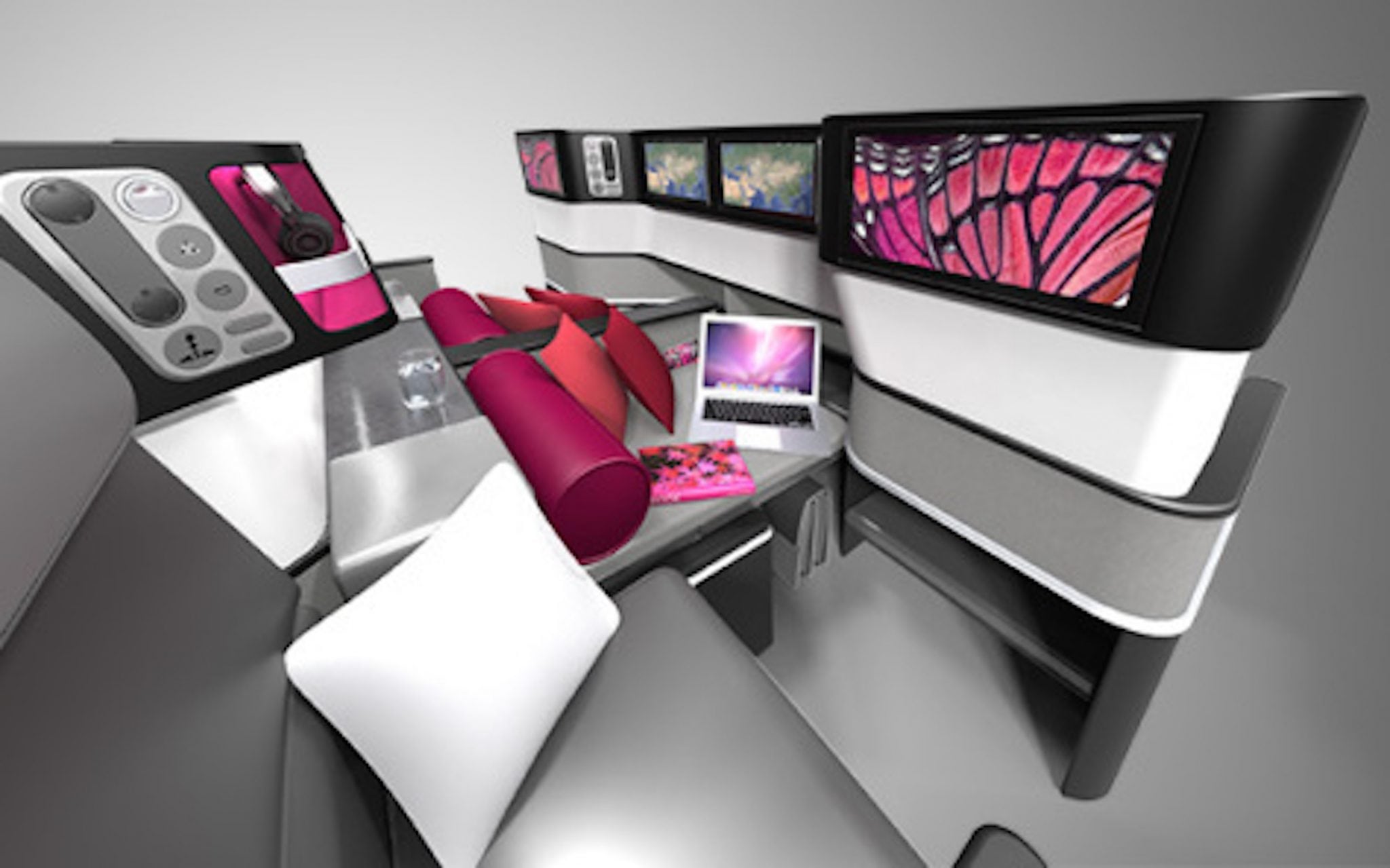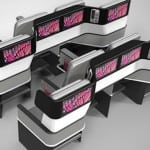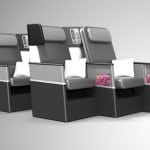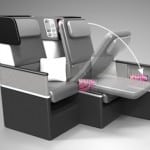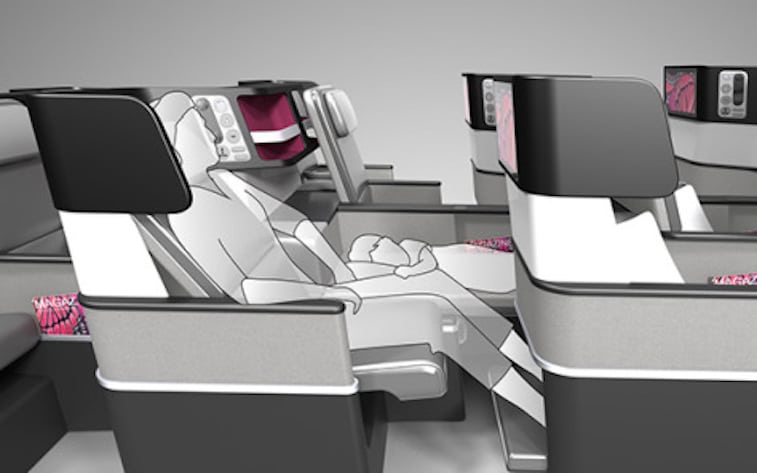Skift Take
In aviation, change takes time and patience pays off. We might have once thought pigs would fly before Butterflies, but airlines could be ready to fly convertibles.
- The Butterfly seat converts from two Premium Economy seats to a Business Class or First Class Suite
- Butterfly Business Class Seat/Paperclip Design
- Butterfly Business Class Seat/Paperclip Design
- Butterfly Business Class Seat Transforming/Paperclip Design
Cabin wars pacifist, James SH Lee, of Paperclip Design, has won the top prize at IATA’s Passenger Innovation Awards for his metamorphosing Butterfly seat.
But is this prize enough for airlines to price it?
Lee is the same designer responsible for the armrest to end the battle of the armrests, and the Meerkat Economy Seat, which would eliminate the need to defend the knees. Yet, the Butterfly has been a bit of a pill for the Hong-Kong based designer. After featuring on Skift, Lee came to the world’s attention.
That world included a certain machinery company which complained of infringement on its claims to the earth, the air, and every other element in between. Non-plussed, Lee put the old name in a cocoon, applied his convertible thinking, and the seat emerged fresh, renamed Butterfly.
The new name suits a design which can adeptly convert and spread its wings. Seats becoming beds are hardly novel, but the combination of features of this design are entirely unique, benefiting both passengers aching for comfort and airlines hurting for cash.
So what airline will fly this award-winning seat?
So far, none.
A seat manufacturer would need to pick up interest in such a design and buy that first, based on customer interest, and then it would have to be sold, built, certified, manufactured and ultimately installed. It will be a while, if it happens at all.
Except it’s more likely to happen now than it ever was, as we’ve learned from one of the judges responsible for the Butterfly’s selection. The first-ever IATA Passenger Innovation Award helps the argument in favor of the Butterfly, and seats like it, along.
Nawal Taneja, Airline Business Strategist, Industry Author, and Professor Emeritus of Ohio State University, was one of the judges who found the Butterfly’s wings appealing. He says of the Butterfly seat concept:
“It is worth looking into concepts that benefit customers and improve the customer experience—and airlines in terms of a potential for higher profitability. Although the convertible seat design is not a new idea, this one seams to be worth exploring a little further.”
The convertible seating concept isn’t new, but the Butterfly’s design is a unique twist on an established theme, combining convertible seating with flexible cabin configurations with limited cabin footprint–principles in vogue in the aircraft interiors sector.
The Butterfly can be two-passenger premium economy seating on one route, and a one passenger business class seat with separate private bed on another route. That bed-on-the side feature would even qualify the Butterfly for first class on certain carriers. One seat, three cabins, all comfortable.
At the Aircraft Interiors Expo, Lee has won three prestigious Crystal Cabin Awards; which are judged by a cadre of aircraft interiors experts. Lee has also won a Spark award, IDEA 2012 award, Platinum A’Design Award, Good Design award, and a Red Dot Award.
Awards don’t necessarily win-over airlines, but a good business case does.
Because space is of the essence in the cabin of tomorrow, other convertible seats concepts which may have been previously ignored are already flying. Airlines, which have previously written off such seats, are thinking twice — so are manufacturers.
The costs of installing new interiors also make flexible cabin options attractive, allowing airlines to change the routes their aircraft fly quickly, without having to first take aircraft out of service to install an upgraded cabin product.
Taneja explains the business case in favor of some of the benefits of this new class of seating.
“To me, the unknowns relate to the cost of the extra space, that is the space efficiency in the cabin, the amount that could be charged for the premium seat, and the potential for a higher load factor, if any. Also, while it is generally accepted that business-class travel provides higher levels of profitability, airlines need to consider: will this trend continue in the future when, finally, low-cost carriers [LCCs] break into the intercontinental market?”
The veteran industry strategist references Norwegian Air Shuttle, Jetstar, Scoot, Azul, and other low-cost airlines as disruptors which make airlines take a second-look at their onboard product and cabin lay-out. The cabin configurations of those lean competitors could shape the cabins of their competitors. Adapting quickly to the cabin competition could be the Darwinian dynamic for airlines.
Taneja believes that the changes brought about by these LCCs, with aims at long-haul routes and international services, once they succeed in obtaining those routes, will have a dramatic and lasting impact on cabin design in general.
“At that time,” he says, “business class fares will come down, and that will raise the question of profitability of the seating configuration. So, there could be a reconfiguration costs, both at the beginning and again at the end if [the cabin design choice] does not work out for an airline. Consequently, while the idea of convertible seating is not new it is worth looking at different ideas to determine their economic viability.”
The Butterfly, and seats like it, could be spreading wings at an ideal time.
Increased cabin density is the new and future reality of our passenger experience. As Ben Orson of JPADesign explained to attendees at the Skift Forum, that reality will work its way right up to the font of the plane. Lee understands this, and has designed his seats to take the ache away, while keeping the elements that make the business case sound.
That this award at IATA’s Wold Passenger Symposium (WPS) is significant. The panel of judges were entirely independent of IATA, and based their award decisions on their own criteria, but IATA is an organisation of the world’s leading airlines. If airlines weren’t tracking Lee’s previous awards, they’ll be aware of this one. That’s the objective of IATA’s WPS, says IATA Spokesperson, Perry Flint.
“From an IATA perspective,” Flint tells us, “the purpose of the awards is to stimulate and encourage fresh thinking and new ideas in the passenger world. These ideas can encompass everything from new consumer apps, to Social Media tools, to seat designs—and more. An added bonus was that the three finalists were able to present their ideas at WPS, where they had exposure to an audience of airline executives as well as others involved in air transport.”
http://twitter.com/IATA/status/523181600499306496/photo/1
The Daily Newsletter
Our daily coverage of the global travel industry. Written by editors and analysts from across Skift’s brands.
Have a confidential tip for Skift? Get in touch
Tags: airline seats, amenities, iata, in-flight
